
- Account Login
- Order Status

- Customer Service

Featured Brands
- Bridgestone
- New Balance
- Sun Mountain
- Tour Striker
- Travis Mathew
- True Linkswear
View All Brands
- Fairway Woods
- Complete Sets
- Womens Clubs
- Junior Clubs
Featured Golf Clubs
- Callaway Epic Flash Driver
- Cleveland RTX-4 Wedges
- Tour Edge Exotics EXS Driver
- Dixon Earth
Shop by Type
Related categories.
- Personalized Golf Balls
- Golf Range Balls
- Limited Flight Practice Golf Balls
- Ladies Bags
- Junior Bags
- Travel Bags
- Golf Bag Rain Covers
- Golf Bag Accessories
- Golf Push Carts
- Electric Carts
- Push Cart Accessories
- Electric Push Cart Accessories
- Golf Cart Accessories
Golf Training Aids
- Impact Position
- Launch Monitors
- Swing Analysis
- Swing Plane
- Weight Transfer
Featured Training Aids
- DST Compressor
- Explanar Golf
- Eyeline Golf
- Impact Snap
- Orange Whip
- Perfect Putter
- Smart Stick
- Swing Glove
- Swing Jacket
- Swing Plane Perfector
- Tour Angle 144
- Golf Practice Equipment
- Golf Putting Greens
- Golf Hitting Mats
- Golf Hitting Nets
- Golf Launch Monitors
- Golf Simulators
- Voice Caddie
Featured GPS Systems
- Garmin Approach S60 Golf GPS Watch
- Bushnell Ion 2 GPS Watch
- Voice Caddie VC300 GPS
- Garmin Approach S20 GPS Watch
- SkyCaddie SX500 Golf GPS
- Garmin Approach G10 GPS
- Bushnell Phantom GPS
- Garmin Approach G80 GPS & Launch Monitor
- SkyCaddie Linx GT GPS Watch
- Golf Rangefinders
- Golf GPS Accessories
- Ian Poulter
- Loudmouth Golf
- Zero Restriction
Accessories
- Ball Retrievers
- Cart Accessories
- Cart Covers
- Club Storage
- Divot Tools
- Golf Club Accessories
- GPS Systems
- GPS Accessories
- Memorabilia
- Nutritional Bars
- Rangefinders
- Range Supplies
- Home > TaylorMade Tour Preferred MB Forged Iron Set (3-PW)

Shop With Confidence
- Free Shipping
- Price Matching
- 100% Satisfaction Guarantee
- Privacy & Security

TaylorMade Tour Preferred MB Forged Iron Set (3-PW)
- Sale Price $799.95 (11% off)
- MSRP $899.95
- Product Code: TM-TPMB
- Manufacturer: TaylorMade Golf
- Availability: Discontinued
- RH or LH: Right Handed
- Flex: Regular Stiff X-Stiff
- Shafts: True Temper Dynamic Gold
- Quantity in Basket: None
- Email your friend
- Free Shipping On Orders Over $75 (Continental United States Only)

The exclusive, 6-step forging process employed produces a more precisely shaped and finished head that looks and performs like a work of art. A thin topline, thin sole, straight leading edge, minimal offset and tapered hosel work in conjunction to promote the kind of pure face-to-ball connection sought after by skilled players.
In addition, the TaylorMade Tour Preferred MB Forged irons incorporate TaylorMade's innovative new precision-weighting port in the back of the clubhead to solve an age-old problem. In the past, clubmakers have installed cartridges of varying weight in the hosel to assure that each iron in the set is of uniform swingweight. Doing so, however, affects the location of the CG in terms of its position between the toe and heel. The TaylorMade Tour Preferred MB Forged irons precision-weighting port guarantees precise swingweights while ensuring optimal and consistent CG location in every clubhead.
"The precision-weighting port proves that it is, in fact, possible to innovate and improve the performance of a true, forged blade." said Brian Bazzel, manager of iron and wedge creation.
The TaylorMade Tour Preferred MB Forged irons also incorporate an advanced, USGA-conforming groove design to promote more spin and control from the rough, a crucial advancement in making it the ultimate player's performance iron. The standard shaft and grip properties were chosen with input from TaylorMade Tour Staff professionals, and include True Temper Dynamic Gold shaft, the most widely played on tour, and Tour Velvet grips, a combination deemed optimal for promoting consistent and responsive performance.
Recent Products
Featured products.
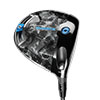
2024 Callaway Paradym Ai Smoke Max Driver

2024 Sun Mountain C-130 Golf Cart Bag
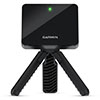
Garmin R10 Golf Launch Monitor & Simulator
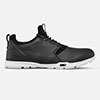
True Linkswear True OG Tour Golf Shoes - Black/White
Power angle pro - golf swing trainer.
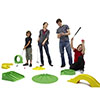
My Mini Golf Professional Set - Miniature Golf Set
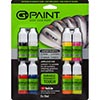
GPaint Golf Club Paint - 8 Pack (All 8 Colors)
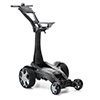
Stewart Q Follow Electric Golf Push Cart - Carbon - w/ Free Accessories
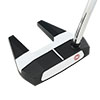
2023 Odyssey White Hot Versa Seven Putter
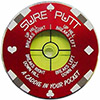
Sure Putt Pro Golf Green Reader & Golf Putting Aid - Red Poker Chip
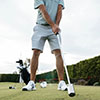
Rypstick Golf Swing Speed Training Aid
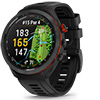
Garmin Approach S70 Golf GPS Watch - Black/47mm - Ceramic Bezel/Black Silicone Band

Company Info
- Privacy Policy
- Returns & Exchanges
- 1-888-733-8383
- [email protected]
- InTheHoleGolf.com
- P.O. Box 11471
- Jackson, WY 83002


- Remember me Not recommended on shared computers
Forgot your password?
Or sign in with one of these services
- Clubs, Grips, Shafts, Fitting
2009 TaylorMade Tour Preferred Irons

By delav , July 18, 2011 in Clubs, Grips, Shafts, Fitting
Recommended Posts
I'm curious if anyone has had these in their bag recently?
I remember hitting these when they first came out, and liking them quite a bit. I'm thinking of picking up a set as an alternative to the AP2s, which are still very expensive.
Any Sand Trap experience?
In the Bag : TaylorMade R11 TP - TaylorMade R7 TP TS - Cleveland Halo - TM TP 2009 3-PW - Vokey SM 52 - Vokey SM 60 - Rife Barbados CS - ProV1x
On the Computer : Analyzr Pro
Link to comment
Share on other sites.
Register for free today and you won't see this ad spot again!

Long Ball Larry
I've been playing them since the end of 2009 and am very happy with them. I started out with the Burners for a few months but switched to the TPs when I got fitted. I'm a big fan from both an aesthetic (looks like a players iron with a thin topline) and functional (cavity back) standpoint. What I like is that I can feel the difference between hitting it flush and catching it a little thin (couldn't do that with the Burners), yet the TPs are still forgiving enough for an intermediate and improving player like me. I got mine new on eBay for either $425 or $450, which was an absolute steal.
That is a steal INDEED!!! I've wanted to try these out for a while, and I'm trying to find one on ebay to try out, 6 or 5 iron hopefully. If you know or see one, let me know!
6-iron: http://cgi.ebay.com/TaylorMade-Tour-Preferred-2009-6-Iron-Stiff-Project-X-/170667462245?pt=Golf_Clubs&hash;=item27bc92ce65
6-iron: http://cgi.ebay.com/TaylorMade-Tour-Preferred-2009-Single-6-Iron-KBS-Stiff-/140459142056?pt=Golf_Clubs&hash;=item20b4046ba8
5-iron: http://cgi.ebay.com/TaylorMade-Tour-Preferred-2009-5-Iron-Stiff-Project-X-/170667461981?pt=Golf_Clubs&hash;=item27bc92cd5d
Unfortunately, I don't think you're likely to find a new set of these since the model is almost three years old. What about trying out the new MCs? They're basically an updated version of the TPs, except the MCs are forged. You can get them on eBay for $600 right now.
Daniel Watkins
One of the better TM irons imo. Very consistent distances and not freakishly long. I give them about a 7.5 out of 10. Hope this helps!
"Advertising is the art of convincing people to spend money they don't have for something they don't need." Will Rogers
Thanks for the replies. I've read a few good threads from when they were introduced, and it looks like sets can be found on eBay for around $300 in good condition. I've hit the new MCs and like the feel, but wasn't wild about them enough to spend $800.
In addition, new grips (midsize) and shaft upcharges push the price of anything new a bit too high for my liking, and I'm a big believer in the value of lightly-used golf equipment.
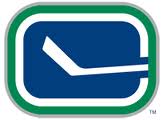
definitely find a good set of TP's and you won't be disappointed. One of TMAG's better irons in the last few years.
- 4 weeks later...
Just wanted to update this thread since the purchase.
I wanted to move from the PX 6.5 to a TTx100, and I found a set that seemed to fit well. This set was +1/4" with Tour Issue TT x100 shafts and a new set of midsize Golf Pride New Decades. These sticks were supposedly built by the tour department (had the tour ferrule) and played by a mini tour player in AZ. Irons were in great shape and I picked them up for $265.
After a few range sessions and 2 after-work nines, I'd have to say I love these irons. The shafts feel wonderful compared to the PX, and these irons are quite a bit more forgiving than my musclebacks without constraining shot shaping too much. This set plays about a club longer for me, and the feel for a cast head is excellent. I can't flight the ball as easily as I could before, but that may come with time and I get used to the new set.
For those looking for a great value in a players cavity, these sticks are very solid.
- 2 years later...
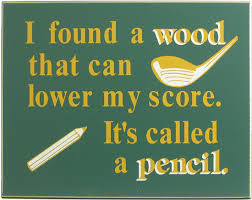
I have these in my bag right now. I bought them used last year, well I swapped a set of diablos for them straight up. I really like them. i never liked the look of gi or sgi irons and when I took them to the range I had no problems hitting them. I also used to own a set of AP2's and found them much harder to hit then these ones. All in all these are a great set of irons that don't just fit in the "player" category. high cappers like myself can hit them with ease.
Create an account or sign in to comment
You need to be a member in order to leave a comment
Create an account
Sign up for a new account in our community. It's easy!
Already have an account? Sign in here.
Topics Being Discussed Right Now on The Sand Trap
The ryder cup ticket prices.
By ChetlovesMer , October 18 in Tour Talk

Wordle Daily Puzzle 1 2 3 4 460
By iacas , January 6, 2022 in The Grill Room
- 8,272 replies
- 355,252 views
- 2 hours ago
"5 Minutes Daily" Practice Challenge 1 2 3 4 904
By iacas , December 31, 2017 in Instruction and Playing Tips
- 5 minutes daily
Tagged with:
- improvement
- five minutes
- 16,269 replies
- 1,094,332 views

Wet conditions
By Hmcgee25 , September 15, 2017 in Golf Talk
- 1,933 views
- 7 hours ago

Pine Valley to Admit Women 1 2 3
By iacas , May 3, 2021 in Golf Courses and Architecture
- 9,721 views

- 16 hours ago
Want to join this community?
We'd love to have you!
TST Partners
By bkuehn1952 · 1 hour ago
By bkuehn1952 · 2 hours ago
By DaHolla · 2 hours ago
By DeadMan · 5 hours ago

By iacas · 6 hours ago
- Existing user? Sign In
- Online Users
- Support TST
- Instructional Content
- On Modern Instruction
- Leaderboard
- Member Reviews
- New Content
My Activity Streams
- All Content (Read/Unread)
- Content I Started
- All Activity
- Instruction
- Member Swings
- Swing Thoughts
- Destinations
- Reading Room
- Fitness/Exercise
- Marketplace
- Disc Golf, Foot Golf, etc.
- The Grill Room
- Announcements/Tech Support
- Private Forums
- Hittin' the Links
- Thrash Talk
- The Numbers Game
Newport Cup
- Newport Cup Home
- Add an Avatar
- Add a Signature
- @Mention Members
- Link to Posts
- Quote Posts
- Embed Videos
- Embed Images
- Create a Poll
- Get an Award
- Advertise with TST…
- Subscriptions
- Manage Purchases
- Personal Information
- Alternative Contacts
- Community Map
- Create New...
Important Information
Welcome to TST! Signing up is free , and you'll see fewer ads and can talk with fellow golf enthusiasts! By using TST, you agree to our Terms of Use , our Privacy Policy , and our Guidelines .
TaylorMade Tour Preferred Better Player Irons Review
Last updated: 09 October 2023

At a glance
- TG Rating 3.5 out of 5
- Owner Rating Not yet rated
What we say...
Get the feedback of a traditional blade with the forgiveness of a modern golf club with the new TaylorMade Tour Preferred golf irons .
How? Through light and long shafts, unsurpassed forgiveness and easy launch technologies have all been stuffed into the Tour Preferred iron but with a thin topline and shorter blade length from toe to heel.
2009 Review
This is a serious player’s club while being very forgiving. The undercut cavity allows weight to be distributed to the perimeter of the head – which helps stability but at the expense of a bit of distance. This ultimately cost this club a higher mark.
Ratings (out of 5)
Web: www.taylormadegolf.eu Telephone: 00 800 8624 4653 Graphite: No
Product Information
Your reviews, taylormade irons user reviews.

TaylorMade Tour Preferred irons review
Check out our review of three TaylorMade Tour Preferred iron ranges
- Sign up to Golf Monthly Newsletter Newsletter
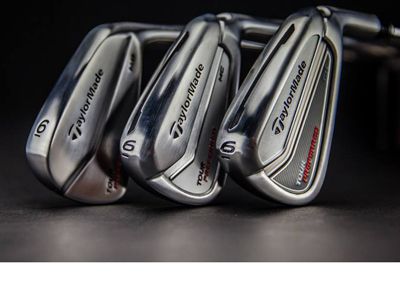
Why you can trust Golf Monthly Our expert reviewers spend hours testing and comparing products and services so you can choose the best for you. Find out more about how we test .
Golf Monthly Technical Editor Paul O'Hagan tests TaylorMade's Tour Preferred irons
Above, Golf Monthly Technical Editor Paul O'Hagan gives his TaylorMade Tour Preferred Irons review.
The clubs come in three models - CB, MB and MC - and were unveiled in January 2014.
The TaylorMade Tour Preferred MB irons are an authentic muscle-back blade forged from soft, 1025 carbon steel with a classic and compact shape, a thin top line and minimal offset.
The TaylorMade Tour Preferred MC irons featuree a muscle-cavity to boost the moment of inertia, creating an all-round iron product with feel, workability and stability.
The 3- 7-irons feature TaylorMade's Speed Pocket to promote increased ball speed in the lower portion of the clubface and more consistency across the entire face.
The head, top-line and sole-width of the Tour Preferred MC are all slighty larger than those on the Tour Preferred MB.
The TaylorMade Tour Preferred CB is a complete cavity-back which combines the shape of a player's iron with the look of a blade at set-up.
The Speed Pocket in the 3- 7-irons feature micro-slots for fast ball speeds across the whole face, as well as higher launch for more distance.
TaylorMade claims the Tour Preferred CB is one of the longest player's irons it has ever created.
The heads of the short irons are compact with minimal offset, and long and middle iron heads are a touch larger with progressive offset, offering more stability and easier launch.
The TaylorMade Tour Preferred CB, Tour Preferred MC and Tour Preferred MC come in 3-iron to pitching wedge with a satin nickel-chrome finish. All three models come with KBS Tour steel shafts and tour velvet grips.
If you decide to buy products from this range, take a look at our helpful TaylorMade discount codes .
Get the Golf Monthly Newsletter
Subscribe to the Golf Monthly newsletter to stay up to date with all the latest tour news, equipment news, reviews, head-to-heads and buyer’s guides from our team of experienced experts.
Nick Bonfield joined Golf Monthly in 2012 after graduating from Exeter University and earning an NCTJ-accredited journalism diploma from News Associates in Wimbledon. He is responsible for managing production of the magazine, sub-editing, writing, commissioning and coordinating all features across print and online. Most of his online work is opinion-based and typically centres around the Majors and significant events in the global golfing calendar. Nick has been an avid golf fan since the age of ten and became obsessed with the professional game after watching Mike Weir and Shaun Micheel win The Masters and PGA Championship respectively in 2003. In his time with Golf Monthly, he's interviewed the likes of Rory McIlroy, Justin Rose, Jose Maria Olazabal, Henrik Stenson, Padraig Harrington, Lee Westwood and Billy Horschel and has ghost-written columns for Westwood, Wayne Riley, Matthew Southgate, Chris Wood and Eddie Pepperell. Nick is a 12-handicap golfer and his favourite courses include Old Head, Sunningdale New, Penha Longha, Valderrama and Bearwood Lakes. If you have a feature pitch for Nick, please email [email protected] with 'Pitch' in the subject line. Nick is currently playing: Driver: TaylorMade M1 Fairway wood: TaylorMade RBZ Stage 2 Hybrid: Ping Crossover Irons (4-9): Nike Vapor Speed Wedges: Cleveland CBX Full Face, 56˚, Titleist Vokey SM4, 60˚ Putter: testing in progress! Ball: TaylorMade TP5x

Matt Wallace has had several caddies in recent years, but his latest is Jamie Lane - here's what we know about him
By Sam Tremlett Published 23 October 24
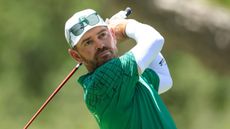
Louis Oosthuizen is one of the most successful players in the professional game - here are some facts you may not know about the LIV Golf star

Max Homa and Collin Morikawa - both born in the Los Angeles area - will be watching their precious Dodgers in the World Series clash against the New York Yankees
By Jonny Leighfield Published 23 October 24
Useful links
- When is the next Prime Day?
- Best 5G phones
- Best VPN services
- Best laptops
- Best smartphones
- Best mattresses
- Best phone deals
- Best mattress deals
- Best TV deals
- Discount codes
- Contact Future's experts
- Terms and conditions
- Privacy policy
- Accessibility statement
- Cookies policy
- Advertise with us
Golf Monthly is part of Future plc, an international media group and leading digital publisher. Visit our corporate site . © Future Publishing Limited Quay House, The Ambury, Bath BA1 1UA. All rights reserved. England and Wales company registration number 2008885.
- FAIRWAY WOODS
- ACCESSORIES
- GOLF COURSES
TaylorMade Tour Preferred Irons
Taylormade tour preferred irons .
TaylorMade Tour Preferred CB 3-PW Iron Set The TaylorMade Tour Preferred CB Iron Set is the latest and greatest from one of the top names in golf. This Tour-preferred set has a cavity back for soft, responsive feel and consistency and allows forgiveness on off-center hits. Additional Features: Shaft: True Temper Dynalite Golf XP Set Composition: 3-Pitching Wedge
USER REVIEWS
This article is truly amazing! I am very impressed with the depth of insight presented and the clear and easy-to-understand writing style. The content of the article is very relevant and informative, providing a deeper understanding of the topic discussed. In addition, the analysis presented is also very profound and provides a different perspective. Thanks to the writer for the effort and dedication in presenting high-quality articles like this. I am looking forward to reading more articles! Read more on: Arta4d
Wonderful Article! tstoto tstoto tstoto tstoto
The TaylorMade Tour Preferred irons are a solid choice for skilled golfers seeking precision, workability, and a classic look. If you have a lower handicap and prioritize control over forgiveness, the Tour Preferred irons could be a suitable option. As with any golf equipment, it's recommended to try the clubs or get professionally fitted to ensure they match your individual swing characteristics and preferences. by tstoto
No weaknesses. All very good.
i no lika thes clubs and bring back too many i get confuse
Customer Service
I just recently purchased a set of 2009 TaylorMade tour preferred irons with TT dynamic gold s300 shafts. I went to try out some irons to replace my Snake Eyes forged cavity backs I have been playing with the past 5 years. I really had my mind set on either Ping s57 or Titleist ap2's but the TaylorMade's were on sale as they were last year's model, so I figured I would give them a shot. I have never been a huge fan of TaylorMade irons in the past. After a 10 minute warm-up, the testing began in the fitting room. All three irons gave nearly identical measures; launch angle being 14-15 degrees and initial ball speed of 132-135 mph for each swing with each. I was using 5-irons for comparison purposes. I was very shocked to find that the TaylorMade's were the longest of the three, but only about 3-4 yards longer than the ap2's. The Ping's brought up the rear in this catagory. Also, the TaylorMade's had the tightest shot dispersion of the three, again with the Ping's being the worst of the three (not bad by any reason, but just not as tight as the other two). The real kicker was on the mis-hit shots (about two out of ten for each club, not bad but not pure smash either), the TaylorMade's still held the line and only lost about 5 yards of distance. I have since played 2 18-hole rounds with the clubs, and the only problem I have had is adjusting to the new distances I am hitting each club, approx 6-10 yards further than my old set. I had even had the old set bent 3 degrees strong, and the new TaylorMade's are still standard loft/lie!! I would be interested in seeing how they perform with Rifle shafts, however I really don't see the need to make any changes at this time as these are vastly superior to any club I have played in the past. I really like the swingweight and the feel of these irons. I pretty much hit a very consistent 5-yard draw with these, and mis-hits are not a disaster. Now, if only I can get better at chipping..........
Have not had to use them, however Golf Galaxy staff was very helpful in choosing this set.
Similar Products Used:
Ping Zing 2, Snake Eyes 600C forged cavity-back. Also demo'd Titleist ap2, Ping s57, Callaway x forged and x-22 and Mizuno mp-58.
I was looking for a new and modern set of irons with a cloassical look, but some forgiveness in order to replace my old Taylormade RAC Combo Set. Tried around a lot. At the end I tried the new Tour Preferred irons and they are at its best. Great feel, the d1 balance was amazing and I had a great feel shot for shot. The only negative remark is the bit harder feel during impact than my old forged irons. But I hit the 3 iron solid from the fairway as well as the PW, they are constant and easy to hit. Also took back some strength, switched from stiff to regular but I am even a bit further (note: with the same loft degree) as with my old driver. For 300 € at ebay this was a great deal.
Ping S57, Ping S58, Macgregor, Mizuno MP52, Taylor Made Tour Burner, Taylor Made RAC TP, Nike Pro Combo etc.
Started this beautiful sports 4 years ago with a set of Callaway Big Bertha irons. Then switched to the Callaway X-Tour Forged 1.5 years ago as my game improved. My handicap has gone down to around 16 to 14 but could not improve any further. Recently I decided I should change the set for one that is more current, with better technology that might help me in my game. After testing a few models - namely Ping S57, TM 2009 TP and Titleist AP2, I settled for Taylormade's Tour Preferred Irons with Project X Flighted shafts. The club looks beautiful at every angle. During my first range session, it took me only about 5 shots to get used to each club. And at the end of it, the only thing in my mind was 'I should have switched to this much earlier!' The feel was excellent, and I might say even better then my last set of forged irons, really buttery coming off the sweet spot, probably due to the Vibration-management Cavity Badge or the undercut cavity. Sound at impact was also solid. Off-center hits were forgiving, with less loss of distance compared to my old irons. I was even striking the ball better with the long irons, with increased confidence. Shots are now more consistent, with more GIR every round. For mid-handicappers and better, who are thinking about getting a new set of players irons, look no further. This set should not disappoint.
Have not used it yet.
Callaway X-Tour Forged
I've been serious about golf for 5 years. I switched over to a set of TaylorMade Tour Preferred irons after playing with Mizuno MP-33's for a couple of years. Before playing the MP-33's, I hit Callaway Big Bertha 2005 irons. Since they were game improvement irons, I was able to play the irons well in a short period of time. After playing with them for 1 year, I decided to switch over to MP-33's since the Big Bertha's lacked feel and workability. At first, the MP-33's were brutal to play with because the sweet spot is the size of a dime. However, after about a year, I learned that in order to hit blades well, you have to slow down your swing. After I figured that out, I loved playing with the MP-33's. I recently decided to buy a set of irons with a little more forgiveness but still maintain workability. Tour Preferred offered just that. Now, I'm striking the ball much better and not paying a heavy penalty for miss hits. If you are looking for a set of irons with blade like features with forgiveness of cavity back irons, I highly recommend trying out the TaylorMade Tour Preferred irons.
Mizuno MP-33's
Hot Deals See All Hot Deals >>
- Terms of Use
- Privacy Policy
(C) Copyright 1996-2018. All Rights Reserved.
golfreview.com and the ConsumerReview Network are business units of Invenda Corporation
Other Web Sites in the ConsumerReview Network:
mtbr.com | roadbikereview.com | carreview.com | photographyreview.com | audioreview.com

A Look Back at TaylorMade’s Tour Preferred Irons (2009)
TaylorMade 2009 Tour Preferred Irons: The Ultimate Game-Changers
When it comes to golf equipment, TaylorMade is a brand that needs no introduction. Known for their innovative designs and cutting-edge technology, TaylorMade has consistently delivered high-quality clubs that cater to the needs of golfers at all skill levels. One such example is the TaylorMade 2009 Tour Preferred Irons, which took the golfing world by storm with their exceptional performance and game-changing features.
Released in 2009, the Tour Preferred Irons quickly became a favorite among professional golfers and amateurs alike. These irons were specifically designed for players who demanded ultimate control, precision, and feel in their iron shots. The Tour Preferred Irons feature a classic muscleback design, forged from soft 1025 carbon steel, which ensures a buttery-smooth feel and unmatched feedback at impact.
One of the standout features of the Tour Preferred Irons is their compact shape and thin topline. This design not only enhances the club’s aesthetics but also inspires confidence at address. The compact shape allows for precise shot-making, while the thin topline gives the player a clear view of the ball, promoting better alignment and focus.
The 2009 Tour Preferred Irons also boast minimal offset, further emphasizing their player-centric design. By reducing the offset, TaylorMade has ensured that the clubhead stays in line with the player’s hands, resulting in improved control and shot shaping capabilities. This feature is particularly beneficial for skilled golfers who prefer to work the ball and manipulate their shots to fit various course conditions.
In terms of performance, the Tour Preferred Irons deliver exceptional results. The combination of the soft carbon steel construction and the muscleback design provides a consistent, penetrating ball flight that allows players to attack pins with confidence. The precise forging process ensures that each iron in the set maintains consistent weight distribution, promoting a consistent feel throughout the bag.
Additionally, the Tour Preferred Irons feature a progressive blade length and sole width throughout the set. This design optimizes performance for each iron, with longer irons offering more forgiveness and higher launch, while the shorter irons provide enhanced control and precision. This progressive design allows players to confidently tackle any shot, regardless of the distance or course conditions.
Furthermore, the Tour Preferred Irons incorporate TaylorMade’s renowned Inverted Cone Technology (ICT). This technology expands the sweet spot of the clubface, ensuring maximum forgiveness on off-center hits. It also promotes consistent ball speeds across the face, resulting in improved distance control and accuracy.
The TaylorMade 2009 Tour Preferred Irons are a game-changing set of clubs that cater to the needs of skilled golfers seeking ultimate control, precision, and feel. With their classic muscleback design, compact shape, and minimal offset, these irons inspire confidence and promote shot-making capabilities. The soft carbon steel construction, progressive blade length, and sole width, along with the Inverted Cone Technology, further enhance the performance and forgiveness of these irons. Whether you’re a professional golfer or a dedicated amateur, the Tour Preferred Irons will undoubtedly take your game to new heights.
What Is TaylorMade Tour Preferred?
TaylorMade Tour Preferred is a high-quality golf club that is specifically designed for professional and advanced players. It is part of the Tour Preferred line from TaylorMade, which is known for its exceptional performance and precision. The Tour Preferred MB model, in particular, is a muscleback player’s blade that is forged using soft, 1025 carbon steel. This forging process ensures that the club provides a responsive feel and enhanced feedback to the golfer.
The shape of the Tour Preferred MB is classic and compact, offering a traditional look that appeals to purists. It features a thin topline, which is the upper edge of the clubface, giving it a sleek and clean appearance at address. Additionally, the minimal offset of the club helps to promote a more controlled ball flight, allowing skilled players to shape their shots with ease.
The Tour Preferred MB is designed to provide excellent workability and control, making it a popular choice among professional golfers. Its precise construction and attention to detail result in a club that offers exceptional performance and shot-making capabilities. The soft carbon steel material used in the forging process also contributes to the overall feel and responsiveness of the club, allowing players to have a heightened sense of control and connection with their shots.
The TaylorMade Tour Preferred MB is a top-tier golf club that caters to the needs of skilled and experienced players. Its muscleback design, forged construction, and classic shape make it a reliable choice for those seeking a high-performance player’s blade.
What Year Did TaylorMade Tour Preferred Come Out?
The TaylorMade Tour Preferred iron model was released in the year 2014. This iron was designed to provide enhanced performance and playability for golfers of all skill levels. It features a cavity back design that offers a balance of forgiveness and control, allowing players to achieve optimal distance and accuracy on their shots. The Tour Preferred irons also incorporate advanced technology such as a speed pocket and face slots, which help to increase ball speed and provide consistent distance, even on off-center hits. These irons have been well-received by golfers and have become a popular choice among professionals and amateurs alike.
What Is A Burner Golf Club?
A Burner golf club, specifically the TaylorMade Burner Irons, is a type of golf club known for its powerful and aggressive design. These clubs are designed to deliver maximum ball speeds and a high launch, making them ideal for players who want to increase their distance and improve their overall game.
The Burner Irons feature a progressive head shape, meaning that the size and shape of the clubhead change throughout the set. This design feature helps optimize performance for different shots and distances. The longer irons have a larger clubhead, providing more forgiveness and stability, while the shorter irons have a more compact head for enhanced control and precision.
In addition to the progressive head shape, the Burner Irons also have varying shaft lengths. This design ensures that each club in the set is properly balanced and delivers consistent performance. The longer irons have slightly longer shafts, which help generate more clubhead speed and distance, while the shorter irons have shorter shafts for better accuracy and control.
The overall design of the Burner Irons is aimed at golfers who want to add power and distance to their game without sacrificing control and accuracy. While they are not considered game-improvement clubs in terms of appearance, they offer many of the benefits typically associated with such clubs.
To summarize the key features of the TaylorMade Burner Irons:
– Powerful and aggressive design – Maximum ball speeds and high launch – Progressive head shape for optimized performance – Varying shaft lengths for consistent performance – Suitable for players looking to increase distance without sacrificing control.
What Year Did TaylorMade Tour Burner Come Out?
The TaylorMade Tour Burner Driver was released in 2008. This club was designed for golfers who wanted to hit the ball long distances on the golf course. It was a significant advancement in club technology from TaylorMade, which improved the performance and distance capabilities for players.
Key points about the TaylorMade Tour Burner Driver:
– Released in 2008, it was part of TaylorMade’s lineup of golf clubs. – The Tour Burner Driver was specifically designed for golfers who wanted to maximize their distance off the tee. – It featured advanced club technology that aimed to optimize ball speed and launch conditions for longer drives. – The club’s design focused on increasing forgiveness and reducing unwanted side spin, allowing players to hit straighter shots. – The Tour Burner Driver was equipped with a large clubhead, providing a larger sweet spot for more forgiveness on off-center hits. – It also incorporated a lightweight graphite shaft, which helped golfers generate more clubhead speed for increased distance.
The TaylorMade Tour Burner Driver was introduced in 2008 as a game-changer for golfers seeking maximum distance off the tee. Its advanced technology and design elements aimed to enhance ball speed, launch conditions, forgiveness, and overall performance.
The TaylorMade 2009 Tour Preferred Irons are a high-quality set of irons that cater to the needs of skilled and experienced players. These irons provide exceptional feel and control, thanks to their forged construction using soft 1025 carbon steel. The muscleback design offers a classic and compact shape, with a thin topline and minimal offset, giving players the confidence to shape their shots.
The Tour Preferred Irons are designed for players who demand precision and workability in their iron shots. The compact size and minimal offset allow for greater control over the ball flight and trajectory, making it easier to shape shots and hit precise distances. The feel at impact is also exceptional, with the soft carbon steel providing a buttery-smooth sensation that experienced players will appreciate.
The Tour Preferred Irons also offer a clean and sleek appearance, with a timeless design that exudes confidence and class. The progressive head shape and shaft length throughout the set ensure consistent performance and optimal launch conditions for each iron. This allows players to have confidence in their clubs and focus on executing their shots with precision.
While the TaylorMade 2009 Tour Preferred Irons may not have the latest technological advancements seen in newer models, they still hold up as a reliable and high-performing set of irons. They are a solid choice for players who prioritize feel, control, and workability in their iron play. If you are an experienced player looking for a set of irons that will allow you to shape your shots and hit precise distances, the TaylorMade 2009 Tour Preferred Irons are worth considering.
- Orenburg Tourism
- Orenburg Itineraries
- Orenburg Hotels
Top Tourist Attractions in Orenburg
- Orenburgskaya Oblast'
- Things To Do In Orenburg
Best Things To Do in Orenburg, Russia
Have you ever visited a new place and felt ‘wow’ about it? For many visitors, it happens at Orenburg.
Orenburg may not be as popular as other cities in Russia, but don’t let that fool you. Orenburg is a smaller but beautiful upcoming tourist destination that is worth a visit. You will be surprised by some of the unique things to do and places you can explore at this hidden destination.
You might wish to revisit it someday again, to take a break and relax at Orenburg.
If you have plans to visit Russia and are not sure if Orenburg should be included in your itinerary, keep reading. In this list, we have put together some of the things to do in Orenburg and around. We have a hunch that if you include this city in your travel plans, you will be thrilled you did so.
Tourist Attractions in Orenburg
Here is the list of things to do in Orenburg and tourist attractions in city.
Orenburg Tsentralny Airport
Address: Ulitsa Aeroporta, Orenburg, Orenburg Oblast, Russia, 460000
- Things to do in 25 Kilometr Pazyezd
- Things to do in Kumertau
- Things to do in Meleuz
- Things to do in Sol-iletsk
- Things to do in Isyangulovo
- Things to do in Austyanovo
- What to do in Orenburg in 1 day
- What to do in Orenburg in 2 days
Orenburg Mennonite Settlement (Orenburg Oblast, Russia)
- 1.1 Introduction
- 1.2 Beginning of the Settlement
- 1.3 Administration, Education, Health
- 1.4 World War I and After
- 2 1990 Update
- 3 Bibliography
- 4 Cite This Article
1959 Article
Introduction.
The province of Orenburg, its capital having the same name, is located on the Ural River in Eastern European Soviet Russia . The region had an area of 47,787 square miles and a population of 1,677,013 after World War II (124,000 square kilometers and a population of 2,179,551 in 2002). The city of Orenburg (renamed Chkalov between 1938 and 1957), established in 1735, is located on the railroad from Samara (Kuibyshev) to Tashkent ; its population was 172,925 after World War II (approx. 548,800 in 2002). The population of the province consists of Russians, Bashkirs, Tatars, and many minority groups including Germans. The capital of Orenburg is a significant trading center between Asiatic and European Russia.
Beginning of the Settlement
In 1892-93 the Mennonites of the Chortitza Mennonite Settlement in the Ukraine sent a commission to the Deyev, landowning Russians, in the province of Orenburg, who had offered some land for sale. Since the commission made the visit during the winter they did not even see the land, which was located some 35-45 miles from the railroad station and about 50 miles from the city of Orenburg. The price per acre was 9 rubles. The land purchased amounted to 67,500 acres, to which 2,700 acres were added later. The purchase was made by the Chortitza Mennonite volost (administration) and the land was distributed among the landless Mennonites of the Chortitza Mennonite Settlement . Each farmer was to have not less than 110 acres and was to be exempt from payment on the land and taxes for two years. One of the Chortitza villages gave each of its families 200 rubles additional aid. The first settlers were already organized into five villages before leaving. They left on four trains from the station of Alexandrovsk (now Zaporizhia ).
The Orenburg settlement is located on the Tchuran, Uran, and Gusicha rivers. At least 25 villages were established. Karl Fast reports that there were 28 before World War II. In 1894-1897 Chortitza, Petrovka, Kantserovka, Kamenka , Deyevka , Nikolayevka, Romanovka, and Feodorovka were established. Starting in 1900 the following additional villages were established: Pretoria, Suvorovka, Dolinovka, Rodnichnoye, Dobrovka , and Kitchkas. All of these were founded by settlers from the Chortitza settlement.

Starting in 1895 the Molotschna Mennonite settlement established the following villages adjacent to the Chortitza Mennonite villages: Kubanka, Klubnikovo , Stepanovka, Aliessovo , Karaguy , Kameshevoye, Chernozernoye, Zelenoye. Additional villages were Zabangul, Lyubimovka, and Pogornoye.
The Orenburg settlement never received an "official" name. Sometimes it was known as the Deyevka Mennonite Settlement and sometimes the Orenburg Mennonite Settlement. After 1917 the settlement was known as Uran Volost.
The first years of the settlement were very difficult. Many of the settlers returned to their mother settlements. Their reports did not raise the reputation of the new settlement. Poverty, long winters, poor soil, remote markets, theft by the surrounding nomadic population, and other factors made the beginning extremely difficult. Crop failures were frequent, but the mother settlement was unable or unwilling to make the necessary loans to give the settlement a good start. The cycle of crop failures was as follows: 1901, 1906, 1911, 1916, and 1921. The worst of all was 1906, when the mother and sister settlements helped by collecting food, clothing, and money for the settlers. Feed for the livestock had to be bought in the vicinity.
In 1907-1908 many of the Orenburg Mennonite settlers joined the Mennonites from the Ukraine in establishing the Slavgorod and Pavlodar settlements in Siberia. Some of the land of those who left the Orenburg settlement was distributed among those who remained.
Gradually the economic life of the settlement became more normal. A number of minor industries were established. About five mills powered by wind and water were operated to grind the necessary flour. One of the better-known water-powered mills was operated by Jacob A. Eckert. The necessary food oil was produced in the mill operated by Johann J. Löwen. In the carpenter and smith shops the necessary furniture and tools were made and repaired. Implement and machinery stores were operated by Jacob Bergen of Klubnikovo and others. Other business enterprises were set up in the villages of Pretoria, Klubnikovo, Dobrovka, and Deyevka. After the Revolution co-operative stores were introduced.
Administration, Education, Health
The administration of the Settlement was the traditional one. Each village had a Schulze , and the Chortitza and Molotschna settlements each had an Oberschulze or Vorsteher. The Chortitza administration was responsible to the Bashkir volost in Akhmerovo, and the Molotschna villages to the Russian Abramov volost. At first the position of the Oberschulze was somewhat unique. He was not only a servant to the villages, but also to the mother settlement in the Ukraine , whose interests he had to represent since the settlement was sponsored by the Chortitza and Molotschna settlements. Later the Orenburg Settlement became more independent. Among the officeholders of the Chortitza villages at Orenburg were Dietrich Lepp, Joseph Friesen, David Froese, Anton Günther, and Isaak Penner. In 1913 under Isaak Penner the Chortitza villages received title of land ownership and thus became independent of the Chortitza Settlement. The officeholders of the Molotschna villages were Bernhard Matthies 1895-99, Abram Fast 1899-1907, and Johann Spenst 1907-17.
After the Revolution the 25 Mennonite villages were organized into an independent volost with its seat in the village of Kitchkas. H. H. Löwen became the secretary and Jacob W. Pries the Oberschulze. The volost was subdivided into smaller districts.
During and after the Russian Revolution of 1917 the Settlement underwent the same changes as other communities. In the immediate vicinity of the settlement the Bashkir and Kirghiz republics were created, the boundary between the two cutting across the Mennonite settlement. Both republics claimed the Mennonite settlement within their boundaries. The controversy between them was settled when the Bashkirs occupied the Mennonite settlement and took it over. The Mennonites were constantly open to exploitation under this arrangement until they were transferred to the Kirghiz Republic. Later developments have been the same as in the rest of Russia .
Other public activities of the settlement were the customary fire insurance, with separate divisions for the Chortitza and Molotschna villages, as well as the Waisenamt (i.e. orphanage office). Medical care was primitive in the early days. The usual midwives and bonesetters ( Knochenarzt ) took care of the basic needs. Among the midwives were Mrs. Jacob Giesbrecht and Mrs. Cornelius Kehler. Johann Braun, who settled in Orenburg in 1902, had some training and experience in the care for the sick and became known as "Dr. Braun." He did much to relieve suffering in the settlements. For a while he was assisted by Dr. Michel from St. Petersburg. After Braun's death in 1911 a Pole by the name of Yunovitch practiced medicine until the outbreak of World War I (1914). In 1922 Dr. Rudolph A. Klassen, under the sponsorship of American Mennonite Relief , served the community until he immigrated to Canada. He was succeeded by Dr. Lassmann. In 1925 the Soviet government opened a hospital in the Mennonite village of Rodnichnoye with Dr. Shostakov in charge.
The settlers established an elementary school in each village. Some of the teachers, e.g., Isaak G. Krahn , David H. Löwen, and Johann B. Mathies, had received a normal teacher's training. The annual salary of a teacher in the early days was 350-650 rubles. Some of the young boys went to the mother settlements for secondary school training. In 1919 twelve of the elementary schools had two rooms.
In 1907 a Zentralschule was established at Pretoria, a secondary school which helped to raise the educational and cultural level of the settlement. One of the outstanding leaders of the school board was P. P. Dyck. Among the teachers of this school were R. A. Riesen, Franz, F. Lehn, Dietrich J. Gossen, P. P. Sawatzky, Fr. F. Froese, P. P. Dyck, D. H. Loewen, D. H. Koslowsky, and F. F. Klassen. In 1918 and 1920 respectively the settlement established additional secondary schools in Deyevka and Klubnikovo . By 1925-26 all the schools were taken over by the Soviet government and administered according to the Marxian philosophy, which is vividly described by Karl Fast.
In 1923 a Bible school was established in Orenburg by an organization of 61 members. Isaak J. Töws was the chairman, Peter Paethkau secretary, and Gerhard Braun treasurer. Jakob Rogalsky was the first teacher and the instruction was given in the home of G. Derksen in Karaguy . During the second year the school had 47 pupils and Jakob Rempel and Peter Koehn were added as teachers. The instruction was given in the home of David Rempel of Kantserovka. During the third year (1925-26) 67 pupils attended the school and the instruction was given in the Mennonite Brethren Church of Kamenka . The pupils came from various other settlements besides Orenburg. The government closed the school in 1927.
World War I and After
During World War I many of the men were drafted for forestry service and hospital work. In many instances the women had to do the work in the home as well as on the farm. In 1915 some six thousand German nationals were interned in the Mennonite and surrounding villages. The novel Das sibirische Tor by Hans Harder deals at length with this incident. After the war most of them returned to Germany . Only a few Mennonite girls married German nationals and went along to Germany .
During and after the Revolution the Orenburg Mennonites suffered severely, although not as much as some of the Mennonites of the Ukraine . Requisitions of property, grain, horses, etc., were common. In 1921 the Settlement experienced a crop failure and starvation set in. In some of the surrounding villages a large percentage of the population perished. The Mennonites organized a relief committee to collect food for distribution among the starving. An attempt was made to take clothing to Siberia in return for food, but it failed. Some help came in 1921 when the American Mennonite Relief reached Orenburg. D. R. Höppner reached Orenburg in March 1922 and supervised the distribution of relief until August 1924. Some fifteen carloads of food supplies were distributed, not only among Mennonites. In addition to this much was done to improve health conditions among the settlers. American clothing was distributed in 1923-24. American Mennonite Relief also established a tractor service to boost agriculture. Thus the crisis of 1921-22 was gradually overcome.
A great problem for the settlement during the Revolution and the years of civil war was the attacks made by the surrounding nomadic population. Some of the young Mennonites organized a Selbstschutz to defend their lives and property, although this action was officially condemned by the churches.
In the early days of the Soviets the Mennonites of Orenburg were permitted to do alternative service, supported by the settlement. In 1920-22 they worked on a large nearby estate. Later exemption from military service became impossible.
After the Revolution, during the NEP period, the Orenburg Mennonite settlement revived its economic and religious life (as is recorded in the pages of Unser Blatt and Der Praktische Landwirt ). The results of the crop failures of 1921-22 and the following years were gradually overcome. In 1925 a co-operative was founded to raise the quality of the seed and livestock of the settlement. The co-operatives, which proved to be a success, established tractor stations, dairying, etc. From 1 January to 1 September, 36 tons of cheese were produced. Great progress was made in agriculture as well as in the cultural and religious activities of the communities. The total population of the Orenburg Mennonite settlement was 5,767 on 1 February 1926. In 1913 the congregations were centered in Deyevka (since 1899) with 1,103 members and 1,615 minor children, in Klubnikovka with 594 souls, and in Karaguy with 286 souls. The last two belonged to the Mennonite Brethren .
During the NEP period the elders of the Mennonite Church and the Mennonite Brethren Church, Heinrich Rempel and Kornelius Vehr, died and were succeeded by Isaak Krahn and David Janz. The relationship between the two churches improved. One writer states, "As never before the children of God are striving toward unity." Bible studies and song festivals were jointly conducted. Plans were under way to construct one large church for use by both groups. Soon the great change came and religious activities were suppressed and survived only in the hearts of individual believers. Rigid collectivization set in.
Some 300 persons migrated to Canada in 1926 under the leadership of Peter P. Dyck. On 9 September 1926 the group left Orenburg in nine freight cars, arrived at Moscow on 15 September, and at Riga on 18 September, and proceeded to Canada.
When the NEP period came to a close in 1928-29 and the new collectivization program was inaugurated many regretted that they had not left Russia. Among the thousands of refugees reaching Moscow in the fall of 1929 there were many from Orenburg. Most of them, however, were returned; some reached Paraguay and Brazil . Many of those remaining in Russia were exiled. Walter Quiring lists nineteen leading settlers, teachers, and ministers who were exiled at this time.
When the German army invaded Russia, the Orenburg Settlement, unlike most of the other Mennonite settlements of European Russia, was not evacuated. This, however, did not mean that the Settlement did not suffer. The exploitation of the settlers during the dark years of the Revolution continued. Again in 1951 the region of the Orenburg Settlement experienced a drought. All religious services were forbidden. In 1951 a letter says, "Religious funeral services cannot be conducted but we are permitted to sing. Nothing is offered to the children" (by way of spiritual life) ( Mennonitische Rundschau , (30 July 1952): 5, 16).
Conditions changed considerably in 1955. Reports reached relatives in America about conversions, religious revivals, and worship services. Not only did the surviving ministers start to preach, but also many of the converted but unordained young men began to conduct meetings and preach. Worship services and Bible study was conducted in the homes and barns of the various villages. It even became permissible to teach some German in the elementary schools. Baptismal services were held. One report stated that 98 persons from eight villages were baptized at one time in the village of Petrovka. Numerous ministers were ordained. The writers were enthusiastic about the privilege of worshiping again.
A letter published in Der Bote (4 January 1956: 7) reported that a group met regularly for worship services and that the congregation was growing. Abram Dyck was the leading minister. Another letter published in the Mennonitische Rundschau (1 February 1956: 6) reported that a group met regularly for worship in the home of Heinrich Unruh at Kubanka and that David Günter was the minister. During the mid-1950s none of the former meetinghouses had been reopened for worship services. In Romanovka the former schoolhouse became a clubhouse and the church was converted into a schoolhouse.
The economic life changed and improved considerably after World War II . All farming was done on a collective basis. One of the letters of 1955 reported that women did not need to work outdoors during the winter. An old couple by the name of Peter Braun was supported by the collective. A letter published in Der Bote (12 October 1956: 8) stated that three men had married Russian women, that they had enough food and clothing, and that they had just received electric lights and radios. The correspondence showed that the young men were drafted into the Russian army. There were no indications that this was not taken for granted. -- Cornelius Krahn
1990 Update
The Mennonites of the Orenburg (Kitchkass) and the old Neu Samara ( Pleshanov ) settlements were not dislodged and permanently relocated as had been the case with most other Mennonites who lived west of the Volga River before World War II. All the farming communities had been collectivized, of course, and sovietization was carried forward in other aspects of community life as well. The churches were all closed in the Stalin era, and the majority of adults and young people had to join the Trud Armia (labor army) during the war.
The repressions of the late 1940s and early 1950s gave way temporarily to a period of recovery and reconstruction after the death of Stalin in 1953. The end of the special regime ( Spetskomandantura ) restrictions for all Germans came two years later. Most of those who left the Orenburg communities during the preceding decade, if they had survived, were able to return to their home villages in this region.
Revivals, which had begun here as early as the late 1940s, were renewed about this time when the arrested church leaders were released. Small groups were able to meet for worship and fellowship once more. There were, however, more arrests in 1958-62. In 1965 those from the Pleshanov region of the former Neu Samara settlements were freed and church life could be organized here once again.
In April 1972, the Donskoi congregation requested registration, but was not granted the privilege until four years later. Construction of a house of worship began immediately, and in the ensuing years this group had become the largest congregation of the area. Daniel Janzen was the Ältester for most of this period. The congregation numbered about 400 members in 1987.
Among the dozen or more older Mennonite villages of this area there were now registered Mennonite Brethren congregations not only in Donskoi, but also in Podolsk and Ischalka, with unregistered groups active in Klinok, Kahan, Kuterlja, Krassikova, Lugovsk , and Totz Koe. The total Mennonite Brethren membership of this area was around 1,000 baptized members in 1987. Some Kirchliche Mennonites lived in these villages also.
Most of the Kirchliche Mennonite congregations in the Orenburg settlements were located in villages once established by Chortitza families from Ukraine . The Ältester of the total body, Diedrich Thiessen, led his own registered congregation at Kitchkass (No. 12) until his emigration to West Germany. This group had about 100 members. Registered congregations were also found in the villages of Chortitza (No. 1), Petrovka (No. 2), Kanzerovka (No. 3), Zhdanovka (earlier Deyevka ) (No. 5), Nikolaevka (No. 6), Fejodorovka (No. 7), Sol-Iletzk (south of Orenburg), and Stepanovka. Unregistered congregations were active in Dolinovka and Pretoria. Seven of these congregations had their own church buildings, and the total membership was around 700 (1987).
A dozen or more Mennonite Brethren congregations were located in these villages also. At least eight of them built new meetinghouses during the 1970s and 1980s. Each congregation had its own Ältester , and the total membership was more than 1,500. Groups were registered in the following locations: Chortitza, Petrovka, Kanzerovka, Kamenka, Zhdanovka, Fejodorovka, Suvorovka, Pretoria, Kubanka, Stepanovka, lisovo, and Susanovo. Hundreds of former Mennonites found their way into nearby Baptist congregations, notably those in the city of Orenburg itself.
During most of the 1980s emigration had not affected the Orenburg communities as it had the Mennonites of western Siberia and Soviet Central Asia , e.g., Kazakhstan and Kirgizia. The whole area was opened to tourists and other travelers, so that east-west exchanges increased significantly during the late 1980s. However, during the late 1980s and the 1990s, the majority of the Mennonite inhabitants of the Settlement immigrated to Germany. -- Lawrence Klippenstein
Bibliography
Der Bote : 10 February, 7 April, 12 May, 1954; 17 August, 21 September, 12 October, 1955; 4 January, 11 January, 18 January, 22 February, 25 April, 2 May, 1956; 23 January, 1957.
Brucks, J. H. and H. Hooge. Neu Samara am Tock. Clearbrook, BC, 1964.
Courier 2, no. 1 (1987): 1-3.
Derksen, Wilma. Mennonite Reporter (11 November 1985): 2.
Dyck, Peter P. Orenburg am Ural . Yarrow, 1951; 2nd ed. Meckenheim, Germany: Warlich-Druck und Verlagsgeselschaft, m.b.H., 1993.
Ehrt, Adolf. Das Mennonitentum in Russland . Berlin, 1932.
Fast, Karl. Gebt der Wahrheit die Ehre . North Kildonan, 1950.
Fast, Karl. Orenburg: die letzte mennonitische Ansiedlung in Osteuropa . Winnipeg: Das Bunte Fenster, 1995.
Hamm, Abram and Maria Hamm. Die Wege des Herrn sind lauter Gate. Gummersbach: Verlag Friedensstimme, 1985.
Harder, Hans. Das sibirische Tor . Stuttgart, 1938.
Hege, Christian and Christian Neff. Mennonitisches Lexikon , 4 vols. Frankfurt & Weierhof: Hege; Karlsruhe: Schneider, 1913-1967: v. III, 308.
Hiebert, P. C. and Orie O. Miller. Feeding the Hungry . Scottdale, 1929: 353 ff.
Hildebrand, Olga. "Die Orenburger Ansiedlung, 1920-1970." Der Bote (8 January 1986): 5, 8.
Klippenstein, Lawrence. "An Unforgotten Past: Recent Writings by Soviet Emigre Baptists." Religion in Communist Lands, 14, no. 1 (Spring 1986): 17-32.
Mennonitische Rundschau : 9 June, 1948; 18 January, 1950; 18 April, 1951; 6 February, 30 July, 6 August, 1952; 14 April, 12 May, 4 August, 15 September, 29 September, 15 October, 1954; 15 April, 27 April, 18 May, 22 June, 27 July, 10 August, 27 August, 24 August, 12 October, 23 November, 7 December, 1955; 1 February, 7 March, 11 April, 18 April, 30 May, 18 July, 8 August, 24 October, 1956; 9 January, 30 January, 1957.
Der Praktische Landwirt (Moscow, 1926): No. 1, p. 10 ff.; No. 10-11, p. 14.
Redekop, David E. "Gemeindeleben in Russland 1985." Mennonitische Rundschau (27 November 1985): 18-22.
Rempel, J. Der Sowjet Hölle entronnen . Kassel, 1935).
Sawatsky, Walter. "Mennonite Congregations in the Soviet Union Today." Mennonite Life 33 (March 1978): 12-26.
Unser Blatt I (1925): 44; II (1926): 23; III (1927): 91 and 146.
Cite This Article
Krahn, Cornelius and Lawrence Klippenstein. "Orenburg Mennonite Settlement (Orenburg Oblast, Russia)." Global Anabaptist Mennonite Encyclopedia Online . 1989. Web. 25 Oct 2024. https://gameo.org/index.php?title=Orenburg_Mennonite_Settlement_(Orenburg_Oblast,_Russia)&oldid=145968 .
Krahn, Cornelius and Lawrence Klippenstein. (1989). Orenburg Mennonite Settlement (Orenburg Oblast, Russia). Global Anabaptist Mennonite Encyclopedia Online . Retrieved 25 October 2024, from https://gameo.org/index.php?title=Orenburg_Mennonite_Settlement_(Orenburg_Oblast,_Russia)&oldid=145968 .

Adapted by permission of Herald Press , Harrisonburg, Virginia, from Mennonite Encyclopedia , Vol. 4, pp. 75-79; vol. 5, pp. 664-665. All rights reserved.
©1996-2024 by the Global Anabaptist Mennonite Encyclopedia Online. All rights reserved.
- Mennonite Settlements in Russia
Navigation menu

IMAGES
VIDEO
COMMENTS
I replaced them with AP2 712 a year ago or so & haven't looked back. I hit thr Titleists more consistent. 09 Tour Preferreds are great but I think the AP2 712 are superior, definitely improved my GIR with them. Quote. TM Qi10 LS 9° at 8.25°, Ventus Black 6X, tipped 1", 44.75". TM Qi10 Tour 3w at 13°, Tour AD-VF 7X, tipped 1", 42.75".
The TaylorMade 2009 Tour Preferred Irons feature a classic blade shape, with a shallow, undercut cavity for any player looking for workability with a bit of forgiveness in their irons. The '09 Tour Preferred Irons feature TaylorMade's Inverted Cone Technology, which increases the sweet spot, giving you faster ball speeds and consistent distance ...
The TaylorMade Tour Preferred MB Forged irons also incorporate an advanced, USGA-conforming groove design to promote more spin and control from the rough, a crucial advancement in making it the ultimate player's performance iron. The standard shaft and grip properties were chosen with input from TaylorMade Tour Staff professionals, and include ...
In addition, new grips (midsize) and shaft upcharges push the price of anything new a bit too high for my liking, and I'm a big believer in the value of lightly-used golf equipment. In the Bag: TaylorMade R11 TP - TaylorMade R7 TP TS - Cleveland Halo - TM TP 2009 3-PW - Vokey SM 52 - Vokey SM 60 - Rife Barbados CS - ProV1x.
Through light and long shafts, unsurpassed forgiveness and easy launch technologies have all been stuffed into the Tour Preferred iron but with a thin topline and shorter blade length from toe to heel. 2009 Review. This is a serious player's club while being very forgiving. The undercut cavity allows weight to be distributed to the perimeter ...
Here's how it works. Golf Monthly Verdict. These TaylorMade Tour Preferred (TP) irons sit at the opposite end of the scale to the TaylorMade Burner Plus. The flight is far more penetrating and what you loose in forgiveness you make up for in feedback and looks. We found we could shape approach shots with these irons with relative ease.
The TaylorMade 2009 Tour Preferred Irons feature a classic blade shape, with a shallow, undercut cavity for any player looking for workability with a bit of forgiveness in their irons. The '09 Tour Preferred Irons feature TaylorMade's Inverted Cone Technology, which increases the sweet spot, giving you faster ball speeds and consistent distance ...
The 2009 TaylorMade Tour Preferred Irons were a game-changer in the golf industry. These irons were designed for the serious golfer who demanded the highest level of performance and precision. One of the standout features of the 2009 Tour Preferred Irons was the advanced technology that went into their construction. TaylorMade utilized a multi ...
The TaylorMade Tour Preferred MB irons are an authentic muscle-back blade forged from soft, 1025 carbon steel with a classic and compact shape, a thin top line and minimal offset. The TaylorMade Tour Preferred MC irons featuree a muscle-cavity to boost the moment of inertia, creating an all-round iron product with feel, workability and stability.
The TaylorMade 2009 Tour Preferred Irons feature a classic blade shape, with a shallow, undercut cavity for any player looking for workability with a bit of forgiveness in their irons. The '09 Tour Preferred Irons feature TaylorMade's Inverted Cone Technology, which increases the sweet spot, giving you faster ball speeds and consistent distance ...
TaylorMade Tour Preferred CB 3-PW Iron Set The TaylorMade Tour Preferred CB Iron Set is the latest and greatest from one of the top names in golf. This Tour-preferred set has a cavity back for soft, responsive feel and consistency and allows forgiveness on off-center hits. Additional Features: Shaft: True Temper Dynalite Golf XP Set Composition ...
Tour Preferred MB is an authentic muscleback player's blade, precisely forged of soft, 1025 carbon steel. The shape is classic and compact, with a thin topline and minimal offset. At the request of the many Tour pros we consulted during the prototype phase, the sole has minimal camber. All three Tour Preferred models are offered in 3-iron ...
TaylorMade 2009 Tour Preferred Irons: The Ultimate Game-Changers. When it comes to golf equipment, TaylorMade is a brand that needs no introduction. Known for their innovative designs and cutting-edge technology, TaylorMade has consistently delivered high-quality clubs that cater to the needs of golfers at all skill levels. One such example is ...
TOUR PREFERRED® IRONS SPEcIFIcaTIONS Iron Left Handed Loft Lie Offset Graphite** STD Flex Graphite SW Steel STD Flex Steel SW Grip 2* No 18˚ 58˚ 3.4 mm 39.25" X,S,R D1 39.25" X,S,R D2 TaylorMade Tour Velvet Round .600 3 Yes 21˚ 59˚ 3.2 mm 38.75" X,S,R D1 38.75" X,S,R D2 TaylorMade Tour Velvet Round .600
Map of Russia with Orenburg Oblast highlighted. This is a list of rural localities in Orenburg Oblast.Orenburg Oblast (Russian: Оренбу́ргская о́бласть, Orenburgskaya oblast) is a federal subject of Russia (an oblast).Its administrative center is the city of Orenburg.From 1938 to 1957, it bore the name Chkalov Oblast (Чка́ловская о́бласть) in honor of ...
Things to do in Orenburg: Discover the top tourist attractions in Orenburg for your next trip. From must-see landmarks to off-the-beaten-path gems. Plan your visit to with our handy list and make the most of your time in this exciting destination.
The city of Orenburg (renamed Chkalov between 1938 and 1957), established in 1735, is located on the railroad from Samara (Kuibyshev) to Tashkent; its population was 172,925 after World War II (approx. 548,800 in 2002). The population of the province consists of Russians, Bashkirs, Tatars, and many minority groups including Germans.
Orenburg Oblast. Orenburg Oblast is a region in the foothills of the Ural Mountains, on the border with Kazakhstan. In addition the region borders Samara Oblast to the west, Tatarstan to the northwest, Bashkortostan to the north, and Chelyabinsk Oblast to the northeast. Overview. Map. Directions.